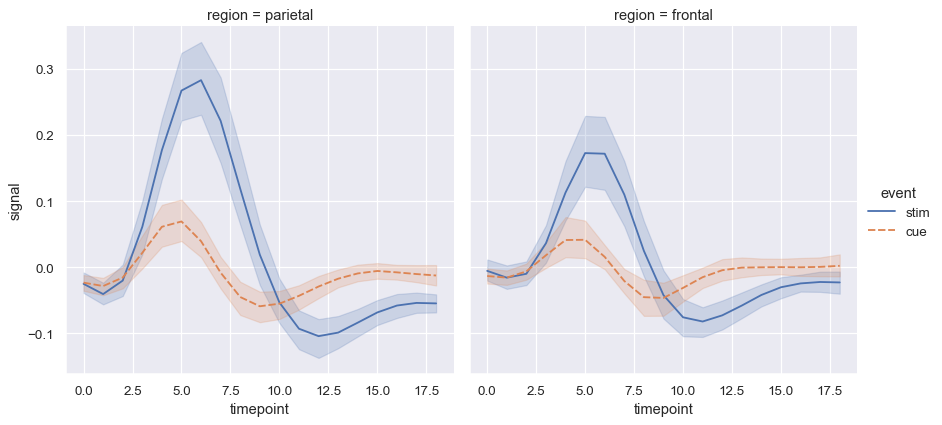seaborn.lineplot(*, x=None, y=None, hue=None, size=None, style=None, data=None, palette=None, hue_order=None, hue_norm=None, sizes=None, size_order=None, size_norm=None, dashes=True, markers=None, style_order=None, units=None, estimator='mean', ci=95, n_boot=1000, seed=None, sort=True, err_style='band', err_kws=None, legend='auto', ax=None, **kwargs)¶Draw a line plot with possibility of several semantic groupings.
The relationship between x and y can be shown for different subsets
of the data using the hue, size, and style parameters. These
parameters control what visual semantics are used to identify the different
subsets. It is possible to show up to three dimensions independently by
using all three semantic types, but this style of plot can be hard to
interpret and is often ineffective. Using redundant semantics (i.e. both
hue and style for the same variable) can be helpful for making
graphics more accessible.
See the tutorial for more information.
The default treatment of the hue (and to a lesser extent, size)
semantic, if present, depends on whether the variable is inferred to
represent “numeric” or “categorical” data. In particular, numeric variables
are represented with a sequential colormap by default, and the legend
entries show regular “ticks” with values that may or may not exist in the
data. This behavior can be controlled through various parameters, as
described and illustrated below.
By default, the plot aggregates over multiple y values at each value of
x and shows an estimate of the central tendency and a confidence
interval for that estimate.
dataVariables that specify positions on the x and y axes.
dataGrouping variable that will produce lines with different colors. Can be either categorical or numeric, although color mapping will behave differently in latter case.
dataGrouping variable that will produce lines with different widths. Can be either categorical or numeric, although size mapping will behave differently in latter case.
dataGrouping variable that will produce lines with different dashes and/or markers. Can have a numeric dtype but will always be treated as categorical.
pandas.DataFrame, numpy.ndarray, mapping, or sequenceInput data structure. Either a long-form collection of vectors that can be assigned to named variables or a wide-form dataset that will be internally reshaped.
matplotlib.colors.ColormapMethod for choosing the colors to use when mapping the hue semantic.
String values are passed to color_palette(). List or dict values
imply categorical mapping, while a colormap object implies numeric mapping.
Specify the order of processing and plotting for categorical levels of the
hue semantic.
matplotlib.colors.NormalizeEither a pair of values that set the normalization range in data units or an object that will map from data units into a [0, 1] interval. Usage implies numeric mapping.
An object that determines how sizes are chosen when size is used.
It can always be a list of size values or a dict mapping levels of the
size variable to sizes. When size is numeric, it can also be
a tuple specifying the minimum and maximum size to use such that other
values are normalized within this range.
Specified order for appearance of the size variable levels,
otherwise they are determined from the data. Not relevant when the
size variable is numeric.
Normalization in data units for scaling plot objects when the
size variable is numeric.
Object determining how to draw the lines for different levels of the
style variable. Setting to True will use default dash codes, or
you can pass a list of dash codes or a dictionary mapping levels of the
style variable to dash codes. Setting to False will use solid
lines for all subsets. Dashes are specified as in matplotlib: a tuple
of (segment, gap) lengths, or an empty string to draw a solid line.
Object determining how to draw the markers for different levels of the
style variable. Setting to True will use default markers, or
you can pass a list of markers or a dictionary mapping levels of the
style variable to markers. Setting to False will draw
marker-less lines. Markers are specified as in matplotlib.
Specified order for appearance of the style variable levels
otherwise they are determined from the data. Not relevant when the
style variable is numeric.
dataGrouping variable identifying sampling units. When used, a separate line will be drawn for each unit with appropriate semantics, but no legend entry will be added. Useful for showing distribution of experimental replicates when exact identities are not needed.
Method for aggregating across multiple observations of the y
variable at the same x level. If None, all observations will
be drawn.
Size of the confidence interval to draw when aggregating with an
estimator. “sd” means to draw the standard deviation of the data.
Setting to None will skip bootstrapping.
Number of bootstraps to use for computing the confidence interval.
Seed or random number generator for reproducible bootstrapping.
If True, the data will be sorted by the x and y variables, otherwise lines will connect points in the order they appear in the dataset.
Whether to draw the confidence intervals with translucent error bands or discrete error bars.
Additional paramters to control the aesthetics of the error bars. The
kwargs are passed either to matplotlib.axes.Axes.fill_between()
or matplotlib.axes.Axes.errorbar(), depending on err_style.
How to draw the legend. If “brief”, numeric hue and size
variables will be represented with a sample of evenly spaced values.
If “full”, every group will get an entry in the legend. If “auto”,
choose between brief or full representation based on number of levels.
If False, no legend data is added and no legend is drawn.
matplotlib.axes.AxesPre-existing axes for the plot. Otherwise, call matplotlib.pyplot.gca()
internally.
Other keyword arguments are passed down to
matplotlib.axes.Axes.plot().
matplotlib.axes.AxesThe matplotlib axes containing the plot.
See also
scatterplotPlot data using points.
pointplotPlot point estimates and CIs using markers and lines.
Examples
The flights dataset has 10 years of monthly airline passenger data:
flights = sns.load_dataset("flights")
flights.head()
| year | month | passengers | |
|---|---|---|---|
| 0 | 1949 | Jan | 112 |
| 1 | 1949 | Feb | 118 |
| 2 | 1949 | Mar | 132 |
| 3 | 1949 | Apr | 129 |
| 4 | 1949 | May | 121 |
To draw a line plot using long-form data, assign the x and y variables:
may_flights = flights.query("month == 'May'")
sns.lineplot(data=may_flights, x="year", y="passengers")
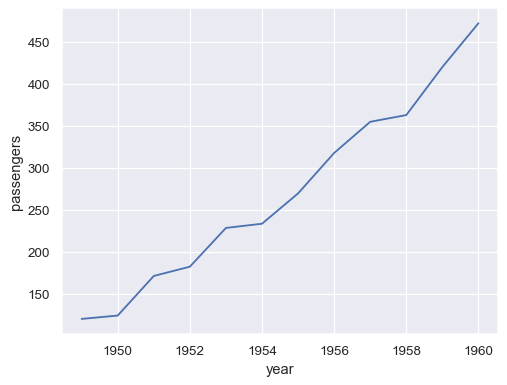
Pivot the dataframe to a wide-form representation:
flights_wide = flights.pivot("year", "month", "passengers")
flights_wide.head()
| month | Jan | Feb | Mar | Apr | May | Jun | Jul | Aug | Sep | Oct | Nov | Dec |
|---|---|---|---|---|---|---|---|---|---|---|---|---|
| year | ||||||||||||
| 1949 | 112 | 118 | 132 | 129 | 121 | 135 | 148 | 148 | 136 | 119 | 104 | 118 |
| 1950 | 115 | 126 | 141 | 135 | 125 | 149 | 170 | 170 | 158 | 133 | 114 | 140 |
| 1951 | 145 | 150 | 178 | 163 | 172 | 178 | 199 | 199 | 184 | 162 | 146 | 166 |
| 1952 | 171 | 180 | 193 | 181 | 183 | 218 | 230 | 242 | 209 | 191 | 172 | 194 |
| 1953 | 196 | 196 | 236 | 235 | 229 | 243 | 264 | 272 | 237 | 211 | 180 | 201 |
To plot a single vector, pass it to data. If the vector is a pandas.Series, it will be plotted against its index:
sns.lineplot(data=flights_wide["May"])
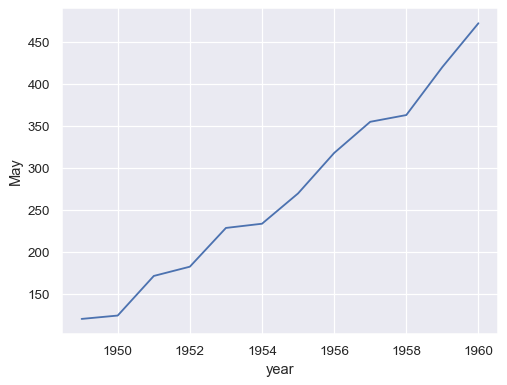
Passing the entire wide-form dataset to data plots a separate line for each column:
sns.lineplot(data=flights_wide)
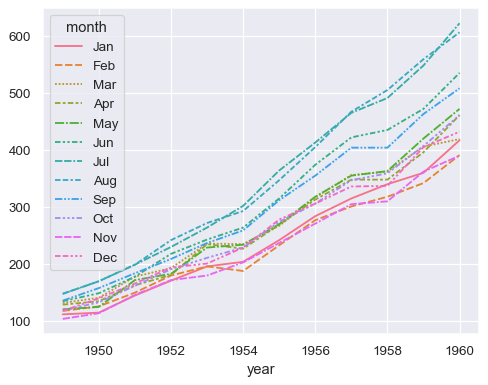
Passing the entire dataset in long-form mode will aggregate over repeated values (each year) to show the mean and 95% confidence interval:
sns.lineplot(data=flights, x="year", y="passengers")
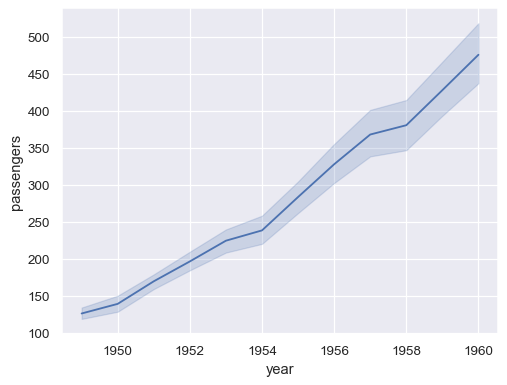
Assign a grouping semantic (hue, size, or style) to plot separate lines
sns.lineplot(data=flights, x="year", y="passengers", hue="month")
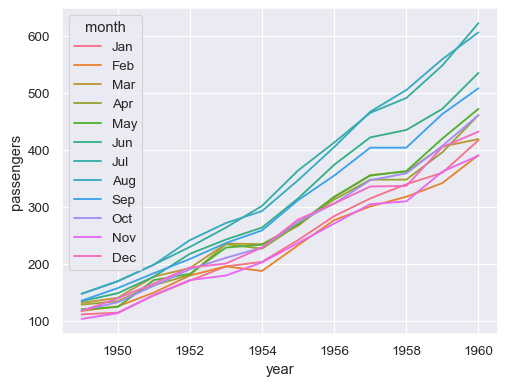
The same column can be assigned to multiple semantic variables, which can increase the accessibility of the plot:
sns.lineplot(data=flights, x="year", y="passengers", hue="month", style="month")
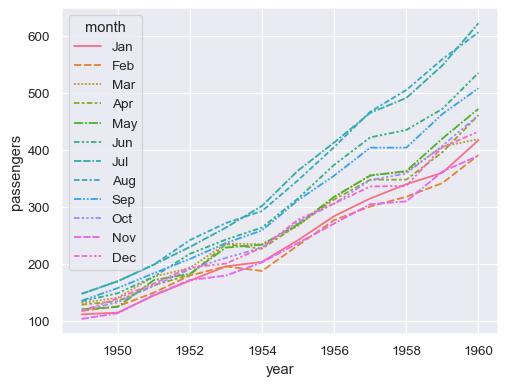
Each semantic variable can also represent a different column. For that, we’ll need a more complex dataset:
fmri = sns.load_dataset("fmri")
fmri.head()
| subject | timepoint | event | region | signal | |
|---|---|---|---|---|---|
| 0 | s13 | 18 | stim | parietal | -0.017552 |
| 1 | s5 | 14 | stim | parietal | -0.080883 |
| 2 | s12 | 18 | stim | parietal | -0.081033 |
| 3 | s11 | 18 | stim | parietal | -0.046134 |
| 4 | s10 | 18 | stim | parietal | -0.037970 |
Repeated observations are aggregated even when semantic grouping is used:
sns.lineplot(data=fmri, x="timepoint", y="signal", hue="event")
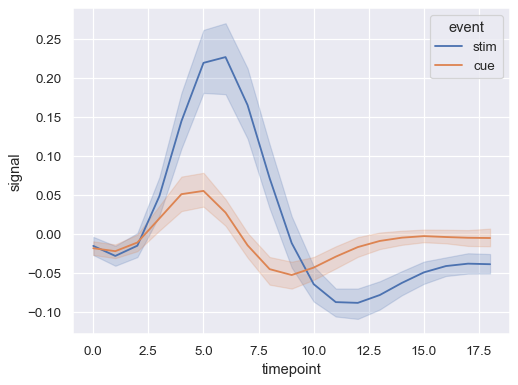
Assign both hue and style to represent two different grouping variables:
sns.lineplot(data=fmri, x="timepoint", y="signal", hue="region", style="event")
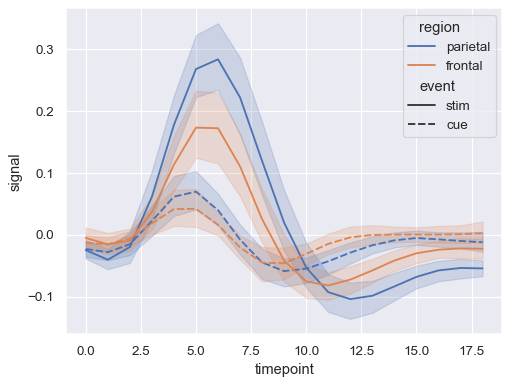
When assigning a style variable, markers can be used instead of (or along with) dashes to distinguish the groups:
sns.lineplot(
data=fmri,
x="timepoint", y="signal", hue="event", style="event",
markers=True, dashes=False
)
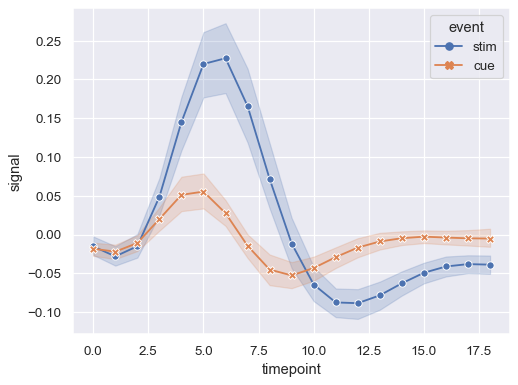
Show error bars instead of error bands and plot the 68% confidence interval (standard error):
sns.lineplot(
data=fmri, x="timepoint", y="signal", hue="event", err_style="bars", ci=68
)
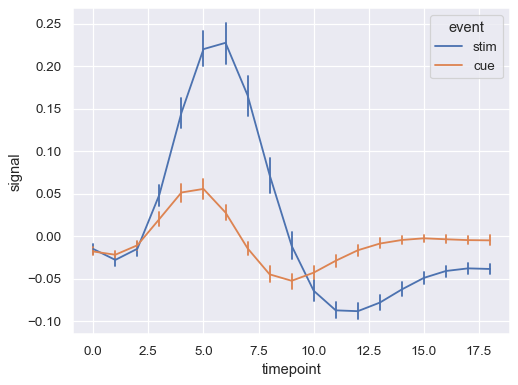
Assigning the units variable will plot multiple lines without applying a semantic mapping:
sns.lineplot(
data=fmri.query("region == 'frontal'"),
x="timepoint", y="signal", hue="event", units="subject",
estimator=None, lw=1,
)
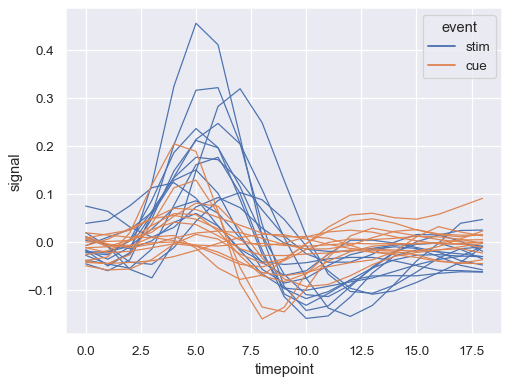
Load another dataset with a numeric grouping variable:
dots = sns.load_dataset("dots").query("align == 'dots'")
dots.head()
| align | choice | time | coherence | firing_rate | |
|---|---|---|---|---|---|
| 0 | dots | T1 | -80 | 0.0 | 33.189967 |
| 1 | dots | T1 | -80 | 3.2 | 31.691726 |
| 2 | dots | T1 | -80 | 6.4 | 34.279840 |
| 3 | dots | T1 | -80 | 12.8 | 32.631874 |
| 4 | dots | T1 | -80 | 25.6 | 35.060487 |
Assigning a numeric variable to hue maps it differently, using a different default palette and a quantitative color mapping:
sns.lineplot(
data=dots, x="time", y="firing_rate", hue="coherence", style="choice",
)
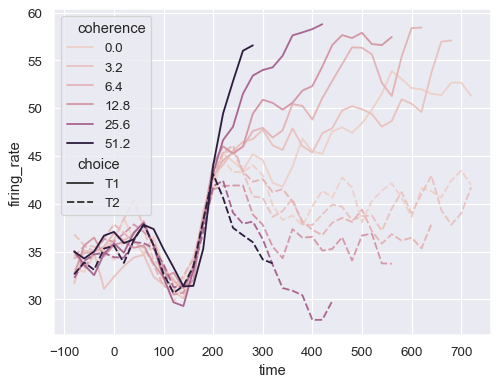
Control the color mapping by setting the palette and passing a matplotlib.colors.Normalize object:
sns.lineplot(
data=dots.query("coherence > 0"),
x="time", y="firing_rate", hue="coherence", style="choice",
palette="flare", hue_norm=mpl.colors.LogNorm(),
)
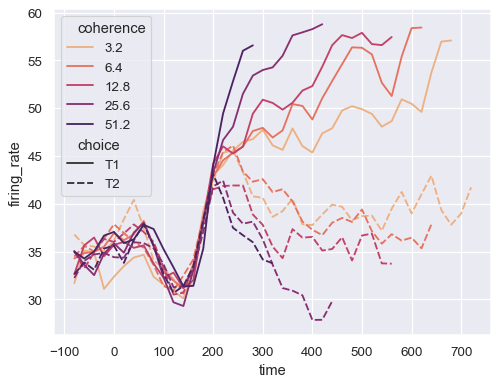
Or pass specific colors, either as a Python list or dictionary:
palette = sns.color_palette("mako_r", 6)
sns.lineplot(
data=dots, x="time", y="firing_rate",
hue="coherence", style="choice",
palette=palette
)
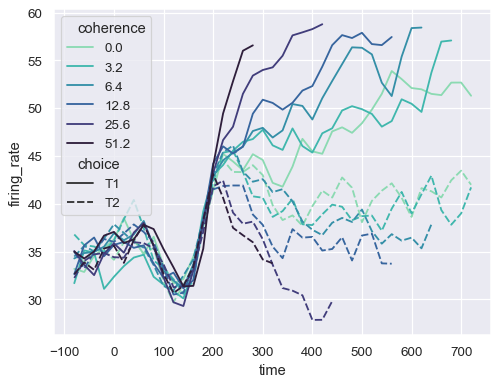
Assign the size semantic to map the width of the lines with a numeric variable:
sns.lineplot(
data=dots, x="time", y="firing_rate",
size="coherence", hue="choice",
legend="full"
)
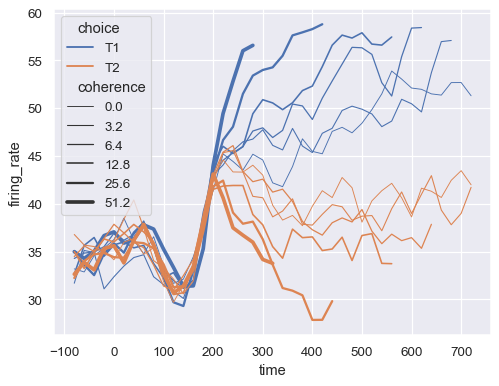
Pass a a tuple, sizes=(smallest, largest), to control the range of linewidths used to map the size semantic:
sns.lineplot(
data=dots, x="time", y="firing_rate",
size="coherence", hue="choice",
sizes=(.25, 2.5)
)
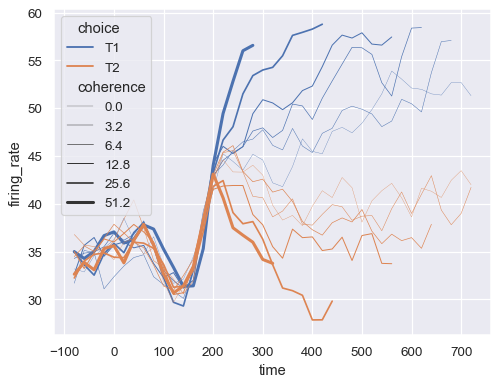
By default, the observations are sorted by x. Disable this to plot a line with the order that observations appear in the dataset:
x, y = np.random.normal(size=(2, 5000)).cumsum(axis=1)
sns.lineplot(x=x, y=y, sort=False, lw=1)
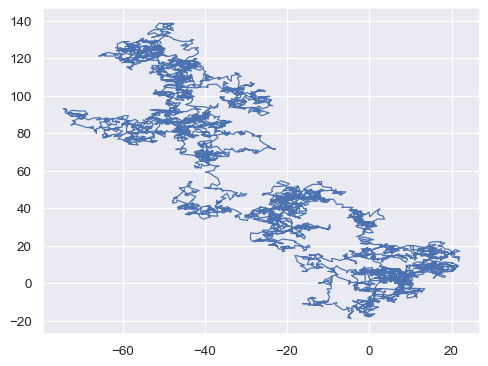
Use relplot() to combine lineplot() and FacetGrid. This allows grouping within additional categorical variables. Using relplot() is safer than using FacetGrid directly, as it ensures synchronization of the semantic mappings across facets:
sns.relplot(
data=fmri, x="timepoint", y="signal",
col="region", hue="event", style="event",
kind="line"
)
